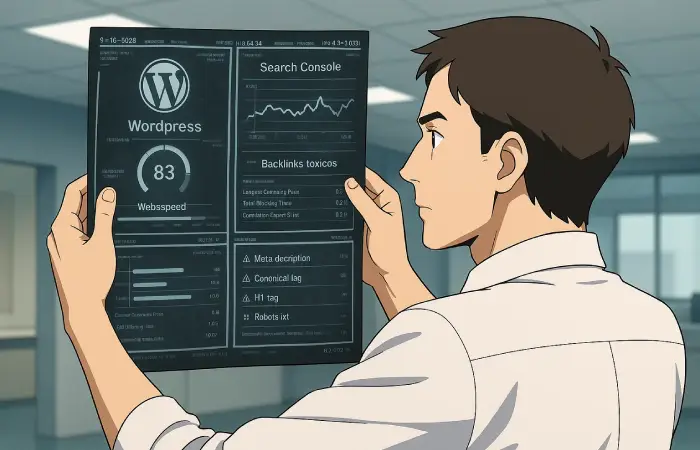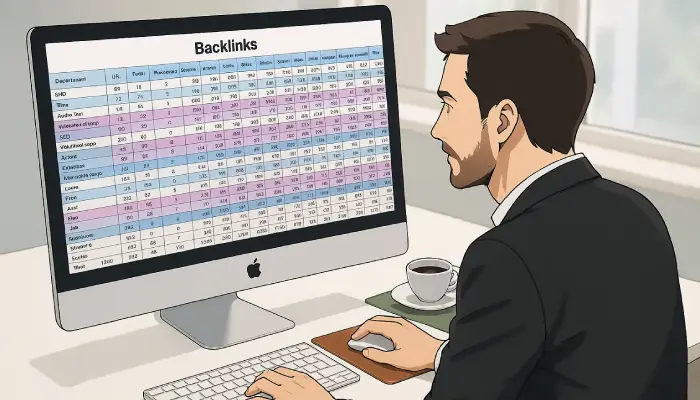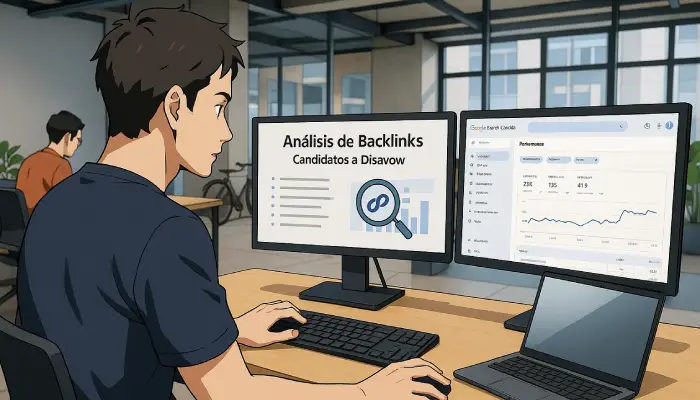So, when should you do it? Only in specific cases: if you have (or suspect) a manual action for unnatural links, or after trying to remove toxic links and it wasn’t possible. It’s not routine cleanup; using it carelessly can do more harm than good.
When should you use disavow?
Before you rush to “sweep” your link profile, keep this in mind: the Disavow Tool isn’t a magic button—it’s a surgical measure. Used well, it helps you tell Google “ignore this noise.” Used poorly, you can cut valuable signals—like jumping without a parachute in organic traffic.
And, when does it make sense to add links to disavow? Here are the cases that truly matter:
- Dead links (broken links from third-party sites): they usually deflate on their own when Google recrawls, so they typically don’t require disavow. Use it only if they come from spam patterns (shady networks) and keep resurfacing via clones or odd mirrors.
- Link farms / toxic links: domains created to link at scale, sites with no real content, inflated metrics, and reckless outbound linking. Here, yes: add them to the list.
- PBNs (private networks): if you detect a constellation of sites with the same footprint (templates, obfuscated WHOIS, shared hosting, unrelated topics) all pointing at you with “optimized” anchors, disavow by domain.
- Black-hat attacks or “negative SEO”: bursts of hundreds of junk links, unusual anchors, random languages, exotic TLDs… If you can’t remove them at the source, disavow to cut the noise.
- Hacked domains: injected pages linking to you from hidden sections—casino, pills, XXX mixed with anything. Straight to disavow, preferably with domain:.
- Anchors you don’t want: anchor text that doesn’t match your editorial line (e.g., “online betting” pointing to a travel blog) or that tries to manipulate your search intent. If it comes from suspicious sites or can’t be removed, disavow.
Disavow myths and risks
Myths (what they don’t tell you)
Myth: “Disavow is my spring cleaning.” Reality: Google already ignores a lot of spam automatically. Using disavow as a routine is a waste of effort and, worse, you might remove valid links. Disavow isn’t for sweeping “just in case”; it’s for specific, well-justified scenarios.
Myth: “I got hit by a core update; I’ll upload a disavow and bounce back.”
Reality: Disavow doesn’t fix algorithmic drops by itself or guarantee quick wins. Recovery depends on the entire context: content quality and focus, search intent, technical SEO (crawl, indexing, canonicals, speed), metadata (title/description/robots), internal linking, and authority signals. If that foundation is weak, disavow won’t save you.
Myth: “I’ll upload disavow.txt today and rank higher tomorrow.”
Reality: There are no shortcuts. Google needs weeks to recrawl and reprocess. And if you over-disavow, you cut signals that were helping; in other words, you can lose visibility.
Risks (what can happen)
Risk: Overdoing it. Disavowing legitimate domains (out of panic or overzealousness) leaves you without natural references. Less is more: act with a scalpel, not an axe.
Risk: Misreading symptoms.
“Ugly” links aren’t always the main problem. Sometimes the hit comes from technical issues, poorly planned metadata, content misaligned with intent, or weak topical authority. If you don’t fix that, disavow is a band-aid on a fracture.
Risk: Chasing ghosts. Many toxic links deflate on their own when Google recrawls. If there’s no clear pattern (farms, PBNs, hacks, attacks), you might not need to touch the file.
If you notice a drop, don’t jump straight into the Disavow Tool: first run a full audit of technical SEO (crawl, indexing, Core Web Vitals), metadata, internal linking, among others, because the dip can come from many places—including algorithm updates. The disavow tool is the last resort and only with evidence: after attempting link removals, use it to ask Google to ignore problematic backlinks; only then, decide carefully.
How to assess whether you really need to disavow links
Red flags
Per Google’s support docs, you should primarily use disavow when there’s a manual action for artificial links in Search Console.
Spikes in low-quality links, obvious link-farm patterns, sitewide footer links, manipulated anchors, hacked domains—ideally, back this up with backlink audits across multiple SEO tools.
Where to audit
In the Links report in Google Search Console: open “Links” in the Search Console sidebar. You’ll see external links (top linked pages, top linking sites, most frequent link text) and internal links. Click “More” to view the full list in each block.
What to check right there (without leaving GSC):
- Top linking sites: spot odd domains, exotic Top Level Domains, irrelevant languages, or sudden spikes. Drill into each domain to see which pages link to you.
- Most frequent link text (anchors): catch suspicious anchors (casino/pills/XXX, repeated exact-match, spam). If a strange anchor spikes, flag it for audit.
Export the available files and, with those CSVs, create simple filters: “domain contains words X,” suspicious Top Level Domains, “many sitewide links to a single page.” This alone isn’t enough to decide, but it gives you a first map.
In SEO tools like Ahrefs, you can play with filters and signals to prioritize what to review. Note: “toxic” scores and labels are directional, not a verdict; use them to prioritize—not to automate disavows. In Ahrefs you could:
1) Quick profile snapshot
Site Explorer → Referring domains / Backlinks
Start with Referring domains and sort by ascending DR; look for domains with 0 traffic to your site and odd patterns (many links in a short time, incongruent topics). Then go to Backlinks with “One link per domain” to reduce noise.
Anchors
Site Explorer → Anchors to spot out-of-place anchors (e.g., “poker,” “casino,” “viagra”) or blatant manipulation. If it lines up with an organic drop or link bursts, prepare candidates for outreach or, if removal isn’t feasible, for disavow.
2) Useful filters (common cases)
- PBN / farms: very low DR + disconnected topics + repeated template/footprint patterns. Prioritize domain: if the entire site looks bad.
- Black-hat attacks / bursts: sort by First seen and date to spot bursts. Cross-check with suspicious anchors.
- Footer sitewide: in Backlinks, keep One link per domain to avoid inflating these cases; review the source page before deciding—footer links often send many links from one domain over a short period.
3) Export and prepare your list
- Export from Backlinks/Referring domains (CSV).
- Manually review samples from each flagged domain (not everything “weird” is bad).
- Build your disavow.txt: use URLs if the site is healthy but specific pages aren’t; use domain: if the entire domain is problematic—otherwise, a single URL is enough.
Step-by-step to disavow in Google Search Console
1) Prepare your list
- Try to remove links first (contact webmasters). If that’s not possible, compile the URLs and domains to ignore.
2) Create the disavow.txt file (correct format)
- One entry per line (full URL or domain:).
- Encoding: UTF-8 or 7-bit ASCII.
- Limits: up to 100,000 lines (includes comments/blanks) and 2 MB; max URL length 2,048 characters.
- Comments with #
Template example (copy/paste)
#Disavow create 09-10-2025 - Reason: Toxic backlinks domain:spam-example.com https://suspicious-site/Guest-post.html #Sitewide footer domain:blogs-x.example3) Upload the file in the disavow tool
- Access the Disavow Links Tool, choose the correct property, and upload your file. You’ll replace the previous list if one existed.
4) Review and timelines
- Changes can take several weeks while Google recrawls and reprocesses.
Quick checklist for the Disavow Tool
- I confirm the manual action or real risk → attempt removal. I audit, identify, and flag the domains and URLs of toxic backlinks.
- I create disavow.txt with the correct rules and limits recommended by Google support.
- I upload the file in the Disavow Links Tool.
- I monitor Search Console and traffic; I expect weeks.
Before uploading anything, download the current list from the tool (save it as a backup): it helps you see what you’ve already disavowed and keep consistency in the cleanup. Note: when you upload a new file, you completely replace the previous one for that property, so pay attention to domains and URLs you add or remove.
Best practices and common mistakes
Best practices (what you should do)
- Prefer domain: when the entire domain is problematic. If it smells like a PBN, farm, or widespread hack, play it safe: domain:example.com and done.
- On quality sites, disavow the specific URL. If the publication is reputable but links from a weird page (comments, profile, tag spam), don’t take down the whole domain—just the problem URL.
- No subpaths or wildcards. The file doesn’t accept /folder/* or regex. Only full URLs or domain:example.com.
- Keep a changelog in comments. Add lines with # showing date, reason, and source (e.g., # 2025-09-11 – PBN detected – outreach failed). It’ll save you later when reviewing history.
- Back up and version: download the current list, keep a copy, and work on a new version. Remember: uploading replaces everything.
- Be minimalist and specific. Less is more: disavow what you have evidence is toxic or manipulative; avoid “just-in-case” sweeping.
- Verify the correct property in GSC. Upload the file to the exact property (domain vs. URL-prefix) so the change isn’t “lost.”
- Document removal attempts. Before using the Disavow Tool, try to remove the link and keep proof (emails, forms, dates).
- Check the nature of the link. If it’s already rel=”nofollow”, sponsored, or ugc properly applied, you normally don’t need to disavow.
- Mind the format—one directive per line, comments with #, UTF-8/ASCII encoding, no smart quotes or odd tabs.
Common mistakes (and how to avoid them)
- Using domain: indiscriminately. Nuking good domains because of one ugly URL makes you lose valuable signals. Rule: domain only if the whole site is bad.
- Trying folders or patterns. domain:example.com/blog/ doesn’t work; Google will ignore that line.
- Disavowing by TLD or “looks” without checking. A .xyz or .tk isn’t bad per se. Check content, context, and patterns before deciding.
- Using disavow to fix algorithmic drops. If the issue is content, intent, or technical SEO, disavow won’t save you.
- No paper trail. Without comments or backups, you won’t know why you disavowed a backlink—or how to revert it.
- Upload and forget. After updating, monitor Google Search Console, traffic, and coverage; the effects take weeks to process.
How to undo a bad disavow
You messed up with disavow.txt… it happens to the best agencies. The good news: you can reverse it. The key is to do it methodically, without rushing, as follows:
1) Back up and check what you broke
Go to the Disavow Links Tool and download the current list. Save it as “backup-before-reverting.txt.” Use it to identify which domains/URLs you shouldn’t have disavowed.
2) Choose your strategy: partial or full
Partial reversal: edit the file and remove only the lines you want to restore—those URLs or domain: entries you marked by mistake. This is usually the best approach.
Full reversal: if the cleanup was a mess, upload an empty file (or delete the entire list) to cancel the disavow completely for that property.
Document and prevent a relapse
Add a changelog inside the file with the date, reason, what you reverted, and why. Set a simple rule for the future:
- On good sites with one bad page → specific URL.
- On domains that smell like PBN, farm, or widespread hack → domain:
- If in doubt, sample and review manually before editing the file.
Be patient—changes aren’t immediate: Google needs weeks to recrawl and reprocess signals. In the meantime, don’t tweak the file every couple of days; let it settle. Monitor performance, links, and manual actions in Search Console as needed.
FAQS
1) What is the Disavow Tool?
2) What is the Disavow Tool for?
3) What kind of links can I disavow with the Disavow Tool?
- Single URL if the site is legitimate but placed a problematic link on a specific page (comments, profiles, odd tags).
- domain: when the entire domain is problematic (PBN, link farm, hacked site, or widespread spam pattern).










